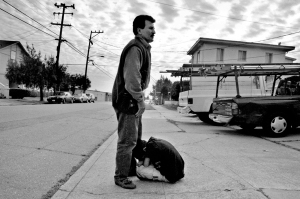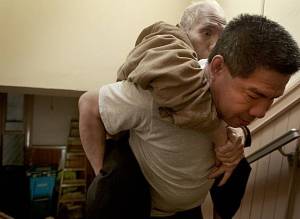Archive for March, 2010
Crisis photography: the conversation
Last week I wrote about war photography, and cited an interesting essay written by Hans Durrer called Photographic Collaboration, published in the journal Soundscapes. With his permission, I am reposting a large portion of his essay here. He writes:
“In times when (some) photographers hold celebrity status, it is useful to be reminded that a good photograph does not solely depend on the photographer’s ability to choose the right subject, location and light, but also on the chemistry and the collaboration, between photographer and subject.
“A good illustration of this is One Step Beyond, the multimedia project about landmines and their victims by the German photographer Lukas Einsele. Because Einsele makes his pictures with a large-format camera, staging is unavoidable because, as he wrote to me in an e-mail: ‘The camera is visible, the photo — its exposition — lasts such a long time that a certain acquiescence has to exist between photographer and subject. Sure, there are exceptions, but actually I’m looking for these common productions by which the subjects become co-authors of an image-reality.’
“When looking at works of photography, viewers often don’t know whether such types of collaboration as those mentioned above have taken place. Sometimes viewers learn about it, more often they don’t. Photographs invite us to ask questions: What do my eyes show me? How did the photo come to be? What doesn’t it show? And so on.
“Walker Evans, while working for the Resettlement Administration in the 1930s, took photos of sharecroppers in Alabama. He portrayed them in their daily lives, at times with worn-out clothes, dirty feet, uncombed hair and unshaven faces, because he wanted to document the circumstances they were living in. That, however, seems not have been to their liking, for there exists one photo — one that Evans did not use in his publications — that shows the family clean and combed and in their Sunday best. One can safely assume that it was taken at the request of the family.
“Despite my deep sympathy for socially inclined photographers, when the people portrayed feel ashamed of their portraits, there clearly is something wrong with this kind of photography.”
This statement, among others, has provoked meaningful responses and arguments on a number of platforms, including this blog. Photographic Collaboration was reposted on the photography forum ZoneZero, where it spurred a lengthy debate between ZoneZero’s Pedro Meyer and Mr. Durrer.
On his own blog, Across Cultures, Mr. Durrer made a similar point to my own last week, that the viewer feels shame looking at certain pictures. In a discussion of Susan Meiselas’ book Nicaragua, published in 1981, he writes, “A very famous photograph shows a young woman running on a road with a near-naked little boy hanging from one arm and a bag slung over her shoulder. The caption explains: Fleeing the bombing to seek refuge outside of Estelí, Nicaragua, Sept. 20, 1978.
“Years later, in a documentary about her work in Nicaragua, Susan Meiselas comments: ‘That photograph is taken by at least five different photographers, at different points during her journey. She is literally vultured by us. No one is thinking to help her, including myself.’
The war photographer and the ones who simply look at these pictures share the same dilemma: both know that these photos should not exist and both are glad that they do.”
I’d love to hear your reactions to these ideas.
I’m also looking for more conversations like this. I know there’s a lot of great posting happening on Lightstalkers, as journalists talk to each other about these issues. Where else? Please send me recommendations of what to read, or post links in the comments on this blog.
War photographer: a dangerous idolatry
Recently, I’ve been thinking about war photography, and the moral arguments that commonly support it. I’ve been seeing people use those arguments to advocate for certain practices in photography in general, and I think there are problems with that.
To me, war-phototography is not the same as non-violent-photography.
For example, in the movie War Photographer, by Christian Frei, photojournalist James Nachtwey describes his process like this: “In a war, the normal codes of civilized behavior are suspended. It would be unthinkable in so called normal life, to go into someone’s home, where the family is grieving over the death of a loved one, and spend long moments photographing them. It simply wouldn’t be done.
“Those pictures could not have been made unless I was accepted by the people I’m photographing. It’s simply impossible to photograph moments such as those without the complicity of the people I’m photographing; without the fact that they welcomed me, that they accepted me, that they wanted me to be there.”
The film shows Nachtwey building relationships, asking questions, and getting to know communities in a conscientious way, even as it also shows him taking pictures in the midst of explosions. But the film emphasizes the picture-taking, not the communication, which I think sends a false message.
I can see how, in a violent situation, neither the photographer nor the subject might be concerned with asking permission or communicating verbally. I can see how permission could be implicit. But I also know that it is easier not to ask permission. It is easier not to communicate. And it’s very easy to misunderstand.
So I’m wary of implicit permission, especially when it’s applied to non-violent situations. I often hear photographers say they are “giving a voice to the voiceless” or “bearing witness.” And when that is the aim, I think that some level of collaboration between photographer and subject—some kind of overt permission—is necessary for the image to have a positive impact.
In a fantastic essay for the online journal Soundscapes, Hans Durrer confronts this issue, saying, “In times when (some) photographers hold celebrity status, it is useful to be reminded that a good photograph does not solely depend on the photographer’s ability to choose the right subject, location and light, but also on the chemistry and the collaboration, between photographer and subject…Despite my deep sympathy for socially inclined photographers, when the people portrayed feel ashamed of their portraits, there clearly is something wrong with this kind of photography.”
That is just an electric statement: When the people portrayed feel ashamed of their portraits, there is something wrong with that kind of photography.
This doesn’t only happen in journalism. It also happens in collaborations between photographers and nonprofit organizations. I spoke to Benjamin Chesterton the other day, who runs the multimedia production company duckrabbit and the blog A Developing Story and he said, “It’s amazing to me that these NGOs’ awareness campaigns will say they’re giving a voice to the voiceless, but you never hear a single actual voice from the community that’s being represented.” This is happening right now with UNICEF’s new Put It Right campaign. Photo/audio slideshows that duckrabbit produces use voices in an incredibly powerful way, as in this one made for MSF (Doctors Without Borders).
Artist Fazal Sheikh photographs war and the issues that surround it, and is a photographer who takes permission seriously, and emphasizes it. Rather than seeing permission as a burden, Sheikh actually builds better projects and makes better pictures by asking permission. Which is intuitive, but not if you’ve just been watching War Photographer.
In his introduction to the book A Camel for the Son, about Somali refugees living in Kenya, Sheikh writes, “I arrived at the camp at Liboi in February 1992 on a UNHCR flight from Nairobi along with news journalists, most of whom were staying for one or two days. The war was fresh and the competition for pictures and stories was fierce.
“I decided to stay on longer and asked one of the Somali leaders whether he would allow me to work in the camp. Some weeks earlier, on the Sudanese border, I had asked an elder the same question. ‘Why are you asking me?’ was his reply. ‘I am only a refugee.’ But his tone made it clear what a violation it was for the refugees to have strangers moving through their communities without their consent.”
This is someone I can look up to. This is someone who has created a process that lines up with his stated goals. He also makes incredibly beautiful images, whose beauty has a lot to do with the energy, self-assertion, and self-possession that people display in front of his lens.
Seeing the strength, the individuality, and the self conscious composure of his subjects, I feel devastated and enraptured; humbled and uplifted. I feel sad. I feel educated. I feel inspired. And I feel proud to be the audience at the end of a photographic process I believe in. By making pictures that his subjects are not ashamed of, he allows me, as the audience, to shed my shame as well.
PhotoPhilanthropy in the Field: notes from King’s Hospital, Haiti
PhotoPhilanthropy founder Nancy Farese has been in Haiti this week, documenting the work of NGO’s providing social services and disaster relief. Her first bulletin described the spontaneous settlements all around the capital. Here, Liz Hale describes their visit to King’s Hospital, with photos by Liz Hale and Nancy Farese.
We traveled on a very rough and rocky dirt road, passing Villambetta Camp which we had photographed with the IRC, and continued just further to their referral hospital. We arrived at Kings Hospital unannounced, with only our IRC friend as a reference, and asked for “Dr. Junie” (Junaie F. Hyacinthe, MD—she is also a pastor).

King's Hospital in Villambetta District, Haiti. Founder, Dr Junaio Hyacinthe visits with a patient and his brother. Nancy Farese
She emerged after fixing a few outdoor cement sinks and greeted us with her warm and open demeanor. She dropped everything to sit and tell us the story of King’s Hospital, Kings Clinic, King’s School and King’s Orphanage—all of which she founded in the last five years. This lady is remarkable; she is an intelligent and charismatic leader, with an avid determination to improve the quality of healthcare for her community.
Her initial funding came in 2005 from the US, prompted by an American friend who encouraged her to come to the States and pitch the story of her experience running an ObGyn clinic in Port-au-Prince. Her dream was to build a hospital. While she found the idea of strangers giving her funds very strange, she decided to try.

This boy had just had hernia sugery, and shared the room with a 70 yera old man who was recovering fromt he same surgery. Nancy Farese
She arrived in Illinois on a Thursday, and left the following Monday with pledges of $110,000. Since then, her American friend has organized many fundraisers to continue support for Dr. Junie’s efforts. There is something very authentic about Dr. Junie and I am certain that people she meets want to help her—I immediately believe in her, just as they do.
The hospital was just shy of completion when the earthquake struck. She opened her half-finished wards to help survivors, and hasn’t slowed down since. She operates as a full-fledged—albeit rudimentary—facility, with a functioning operating room and many patients.
It is sparse and simple, but clean and staffed. Medical supplies have been donated from the US which has allowed the hospital to continue to see patients. The number of operations they perform has sky-rocketed.





















